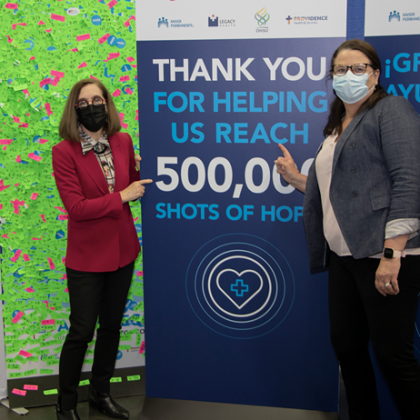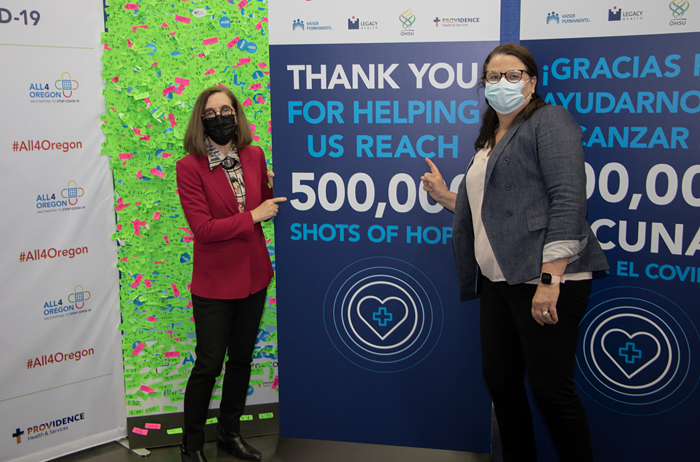Feature your business, services, products, events & news. Submit Website.
Breaking Top Featured Content:
UPDATED: “We are ready”: Oregon Will Reopen No Later Than June 30, Governor Brown Announces


Oregon will lift almost all remaining COVID-19 safety restrictions no later than June 30.
Governor Kate Brown signed an executive order Friday that will remove mask, physical distancing, and building capacity guidelines when the number of Oregon adults with at least one dose of the COVID vaccine reaches 70 percent of the state population, or on Wednesday, June 30—whichever occurs first. As of Thursday, June 24, 68.9 percent of adult Oregonians have received at least one dose of the vaccine.
The new executive order supersedes all existing COVID safety-related executive orders signed by Brown, but still extends the emergency declaration for the ongoing pandemic through December 31, 2021. The emergency declaration gives Brown the ability to authorize emergency recovery efforts, like funding vaccination efforts, expediting unemployment claims, Oregon’s access to the Federal Emergency Management Agency (FEMA), and more.
Masks will still be required in health care settings, airports, and public transit after June 30. Brown will hold a press conference announcing the new executive order at 11 am. You can watch it live the recording here:
The original target for lifting COVID safety restrictions was the 70 percent vaccination benchmark—which is equivalent to about 55 percent of the entire Oregon population having received at least one dose of the vaccine. The Oregon Health Authority (OHA) projected in early June that Oregon would reach 70 percent vaccination status by June 21, but vaccination rates have dramatically fallen over the past few weeks. One month ago, Oregon averaged just under 30,000 doses of the vaccine administered per day. Currently, the state is administering an average of 7,196 doses per day.
“I’m proud of our collective efforts to vaccinate more than 2.3 million Oregonians,” Brown said in a Friday morning press release. “It is because of this success that we can move Oregon forward, and into the next chapter of this pandemic. We are ready.”
The racial and ethnic equity gap in vaccination rates has many stakeholders in Oregon’s communities of color worried about the state’s reopening, especially as the Delta variant of the virus—a more transmittable strain of COVID—grows within the US. About 44 percent of Black Oregonians and 42 percent of Indigenous and Latinx Oregonians have been vaccinated, in comparison to about 60 percent of white Oregonians. The vaccination rates for Black, Latinx, and Indigenous communities, however, are higher than rates for white Oregonians, indicating that the vaccine equity gap is steadily closing.
During a press conference Friday, OHA Director Pat Allen said Oregon has a goal of vaccinating 8 in 10 adult Oregonians of color by the end of August. Individual counties will lead vaccination efforts and receive support from OHA, according to Allen.
“We must recognize that it has been exceptionally difficult for our Black, Indigenous, Latino, Latina, Latinx, Asian, Pacific Islander and Tribal communities,” Brown said. “Disparities that existed before are even wider now.”
Vaccination rates also vary across the state. Over 70 percent of adults in Multnomah County and 65 percent in Clackamas County have received one dose of the vaccine, while Eastern Oregon counties like Malheur have only vaccinated 35 percent of the adult population.
During the press conference, state epidemiologist Dean Sidelinger said individuals who are not vaccinated or are immunocompromised may want to consider changing some of their activities as the state opens up.
“The environment right now with vaccinations driving down infection has allowed us to move into this location where individual, local decisions can be made based on community circumstances,” Sidelinger said. “Those individuals, families, and parents of children will make decisions about the risk that they may be taking when they go out, but also the protection that already exists from our high rates of vaccinations.”
The state is still trying to incentivize vaccine-hesitant Oregonians with cash prizes, like the “Take Your Shot, Oregon” campaign which boasts a main prize of $1 million, as well as smaller $10,000 prizes.
Continue Reading at PortlandMercury.com here
